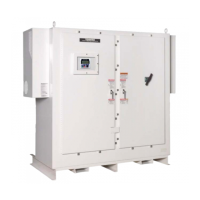126 HX7+ ASD Installation and Operation Manual
Number of Retries
Program Protection Retry/Restart
After a trip has occurred, this parameter sets the number of times that an
automatic system restart is attempted for a qualified trip.
The trip conditions listed below will not initiate the automatic Retry/Restart
function:
• U, V, W Phase Short Circuit,
• DBR Resistor Overcurrent,
• Input Phase Loss (Input Phase Failure),
• Output Phase Loss (Output Phase Failure),
• Overcurrent During Acceleration (Startup Overcurrent),
• Earth Fault (Ground Fault),
• EMG (Emergency Off),
• EEPROM Data Fault (EEPROM Fault),
• Flash Memory/Gate Array/RAM-ROM Fault,
•CPU Fault,
• Communication Error,
• Option Fault,
• Output Current Protection Fault,
• Sink/Source Setting Error,
• Over-Speed Error, or
• Key Error.
See the section titled General Safety Information on pg. 1 for further
information on this setting.
Direct Access Number — F303
Parameter Type — Numerical
Factory Default — 00
Changeable During Run — Ye s
Minimum — 00
Maximum — 10
Dynamic Braking Enable
Program Protection Dynamic Braking
This parameter Enables/Disables the Dynamic Braking system.
Settings:
0 — Enabled with Overload
1 — Disabled
Dynamic Braking
Dynamic Braking uses the inertial energy of the load to produce a braking
force or it may be used to reduce the bus voltage in an attempt to preclude an
over-voltage trip during deceleration. The inertial energy of the load drives the
rotor and induces a current into the stator of the motor.
The induced stator current (energy) is dissipated through a resistive load. The
resistive load is connected across terminals PA and PB (non-polarized). Using a
low-value, high-wattage resistance as a load for the generated current, the
resistive load dissipates the induced energy. The dissipated energy is the energy
that would otherwise have caused the rotor to continue to rotate.
Dynamic Braking helps to slow the load quickly; it cannot act as a holding
brake.
The Dynamic Braking function may be setup and enabled by connecting a
braking resistor from terminal PA to PB of the drive and providing the proper
information at
F304, F308, and F309.
For additional information on selecting the proper resistance value for a given
application contact the Toshiba Customer Support Center.
Direct Access Number — F304
Parameter Type — Selection List
Factory Default — Disabled
Changeable During Run — No
F303 F304

